Business Microeconomics Instructor: Gulnara Moldasheva 1 Organizing Production
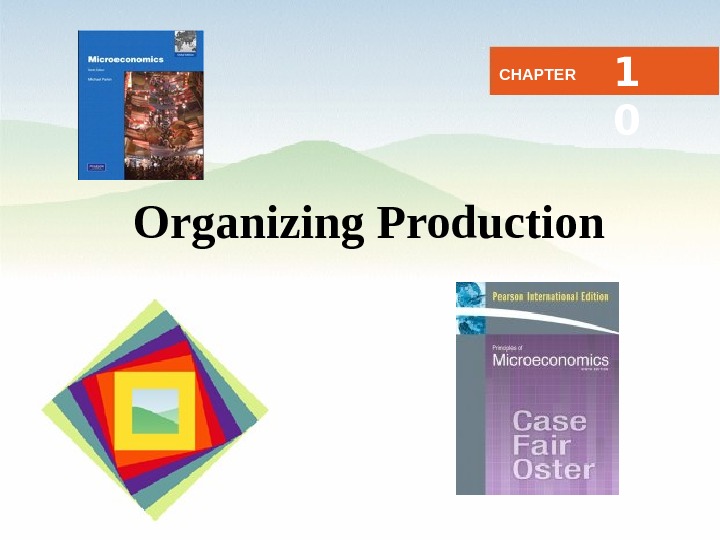

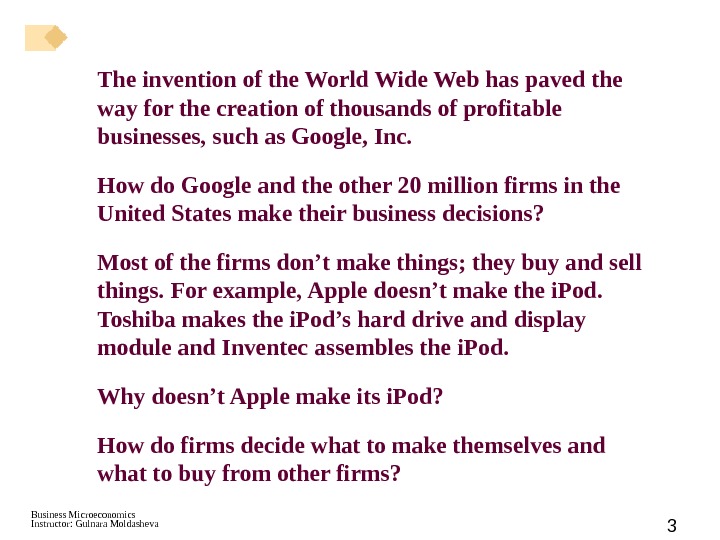


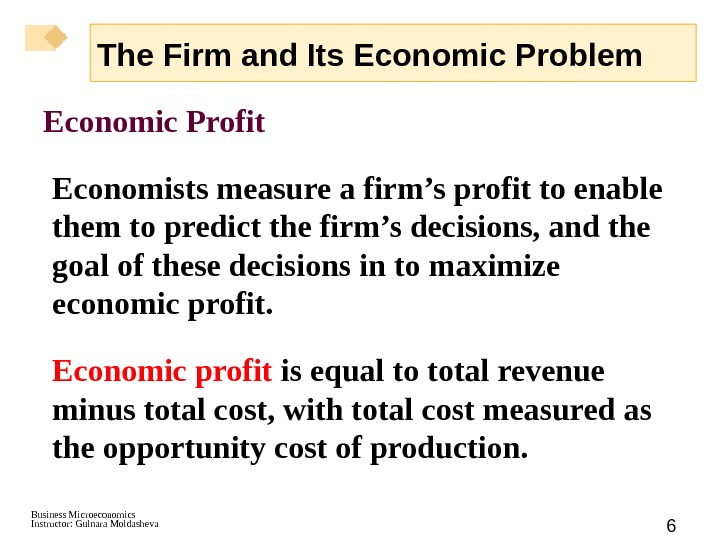

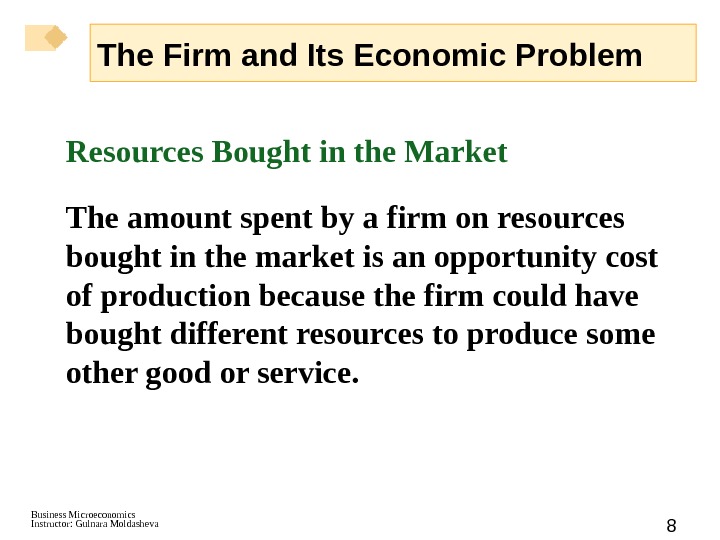

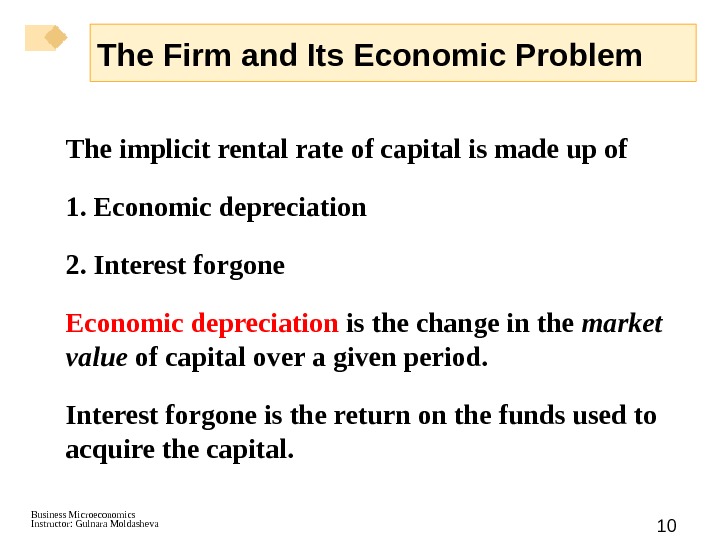

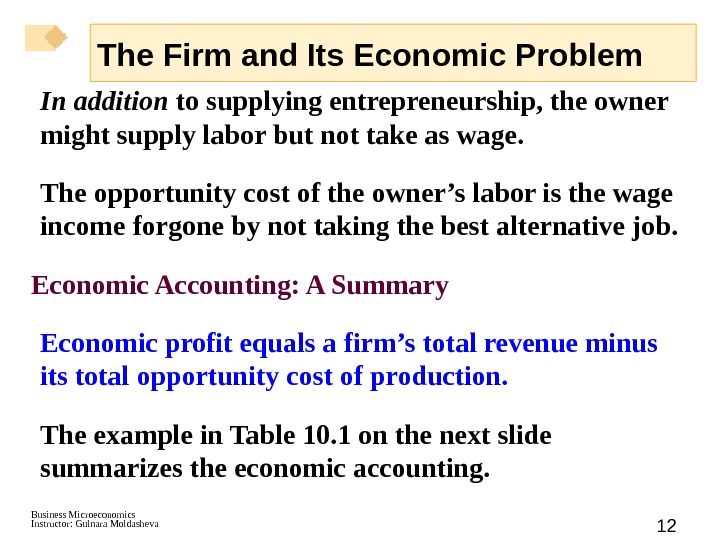



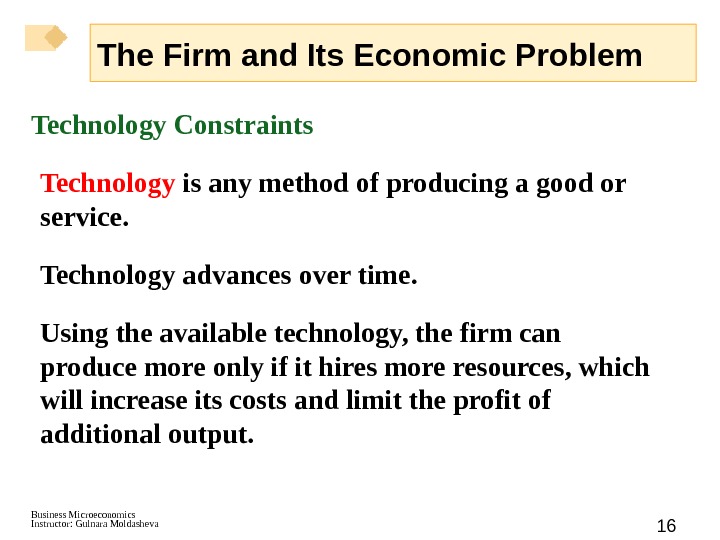

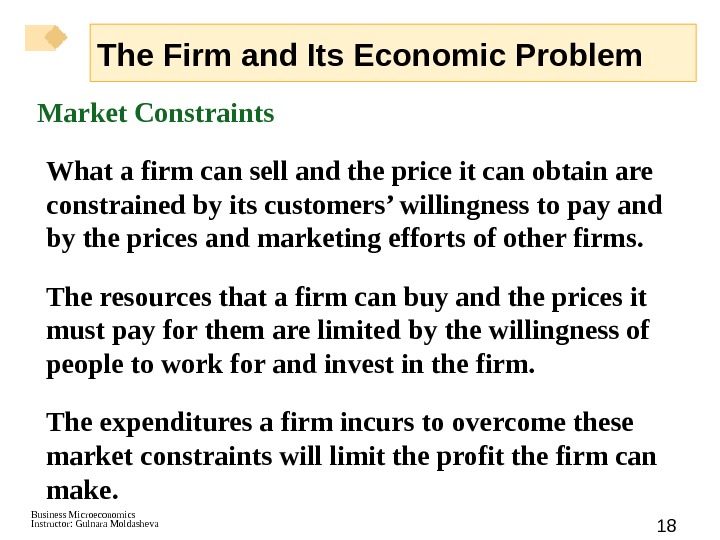
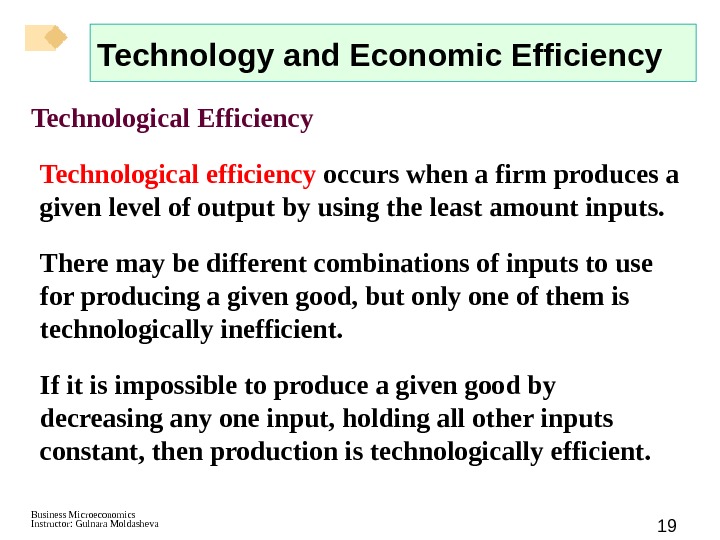
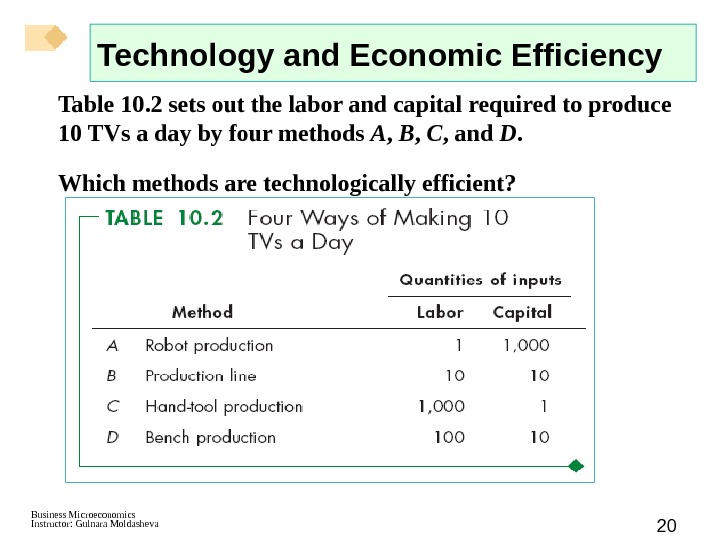
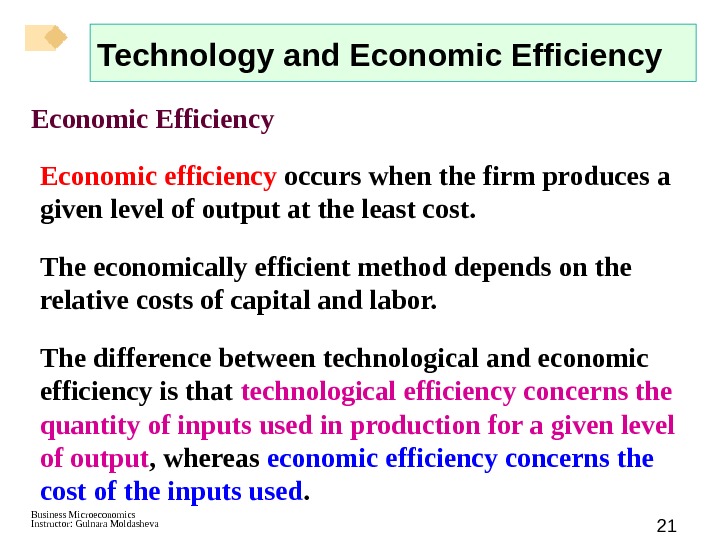
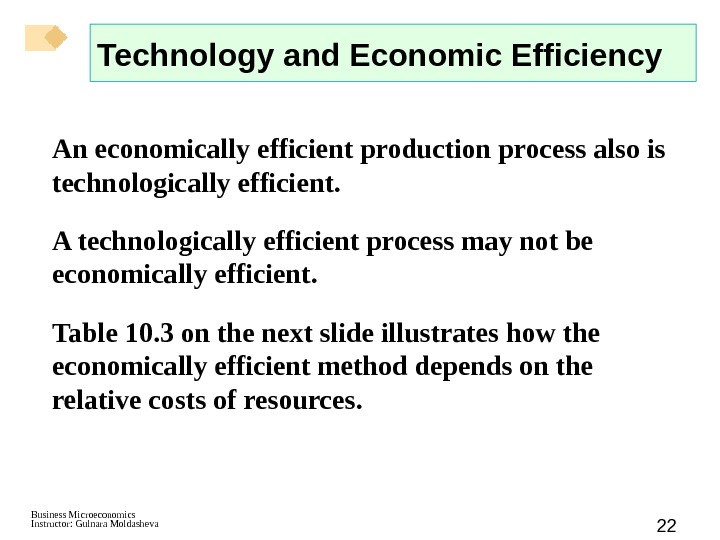
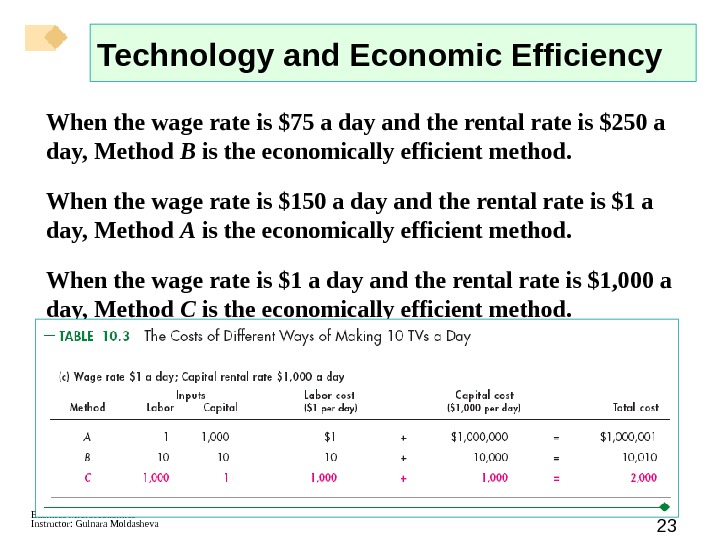
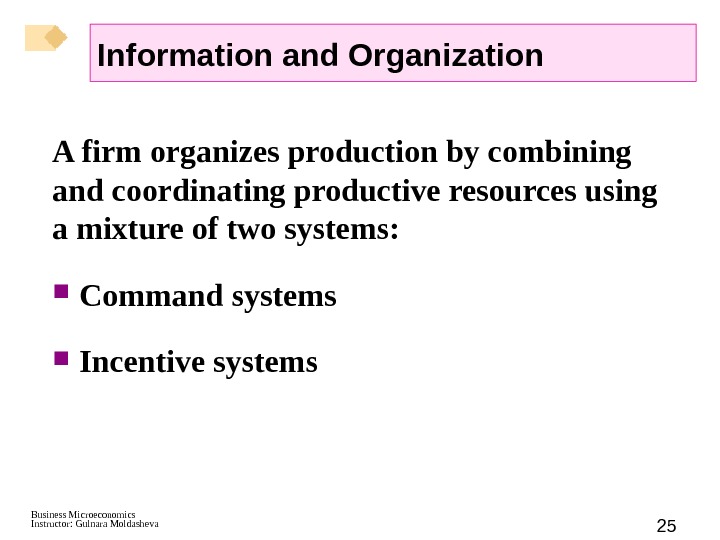
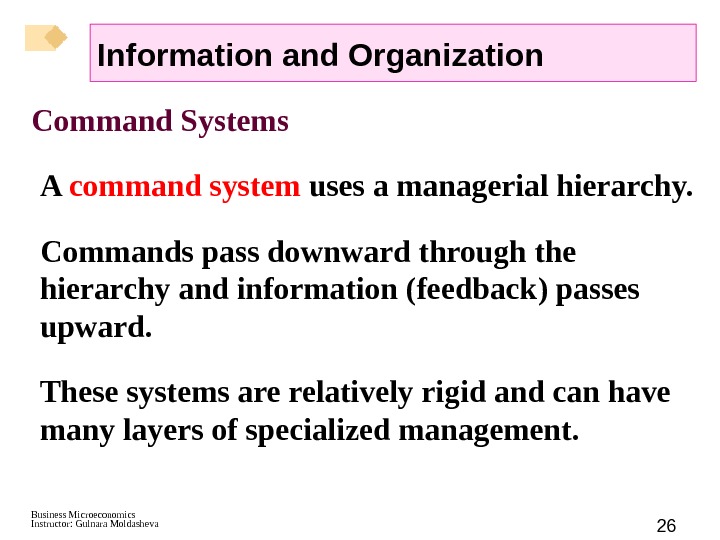

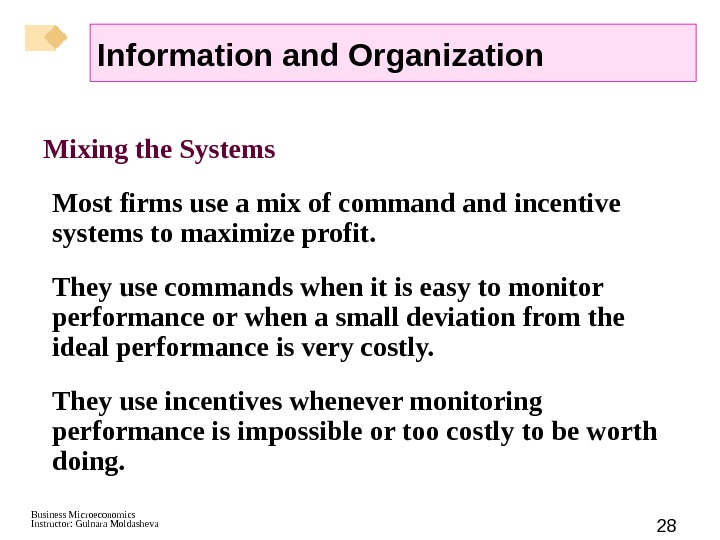


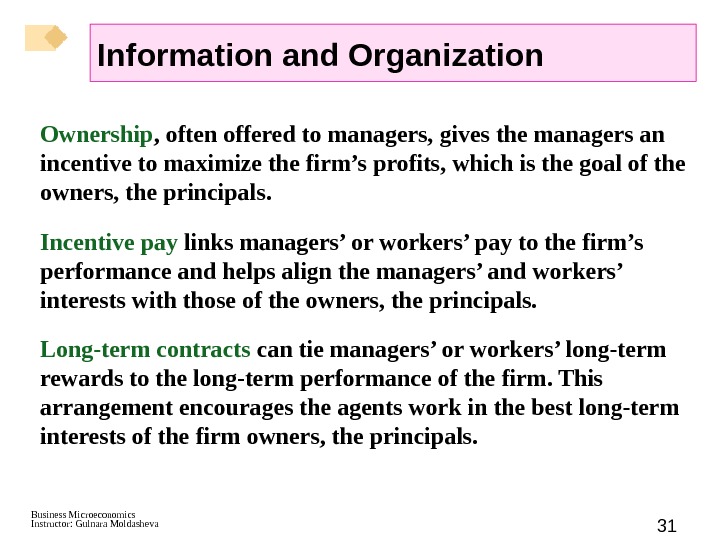

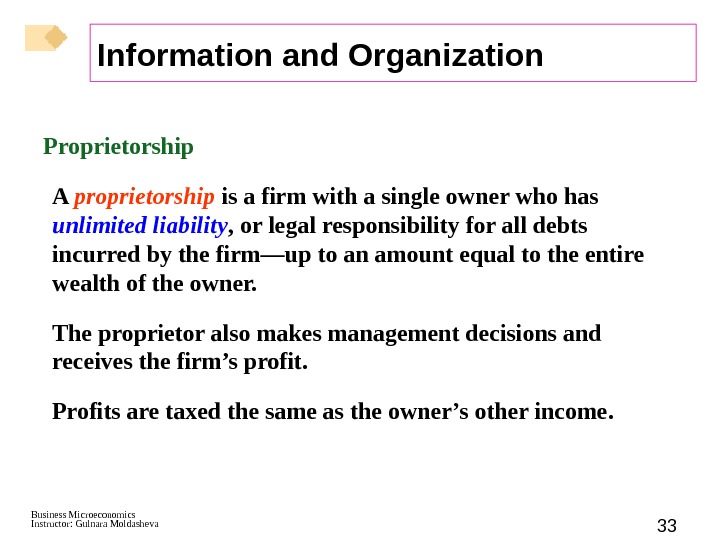




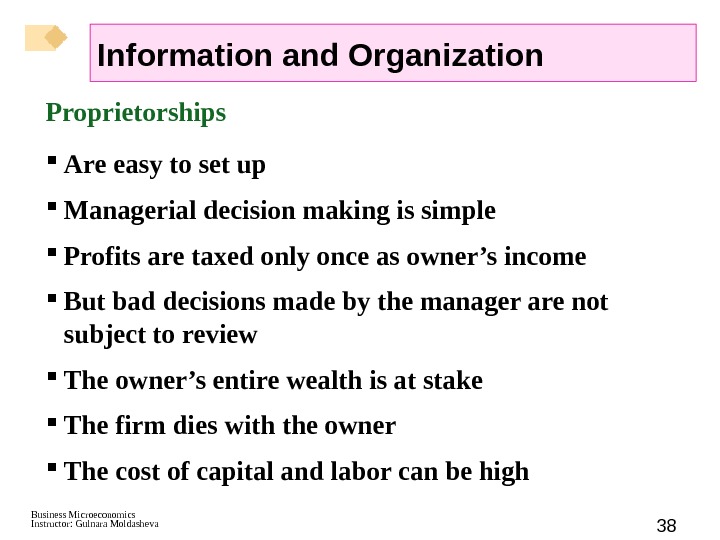
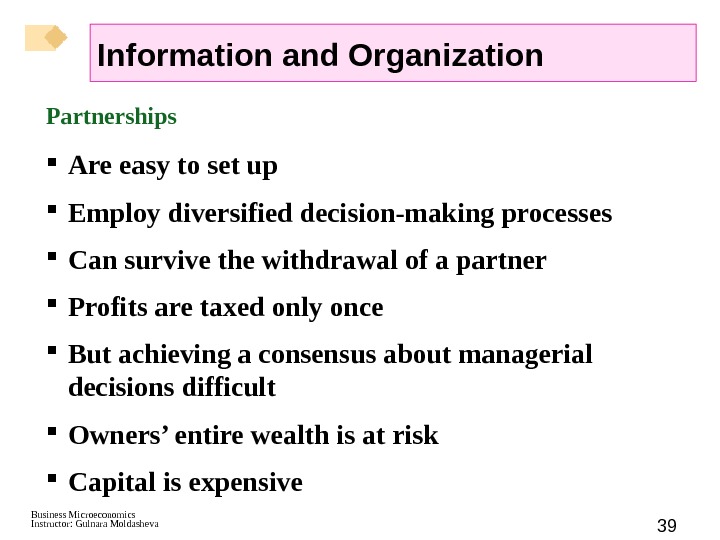
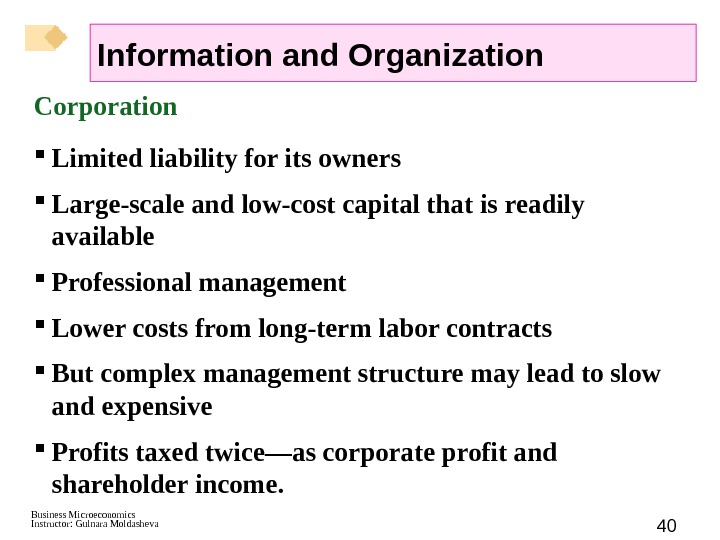
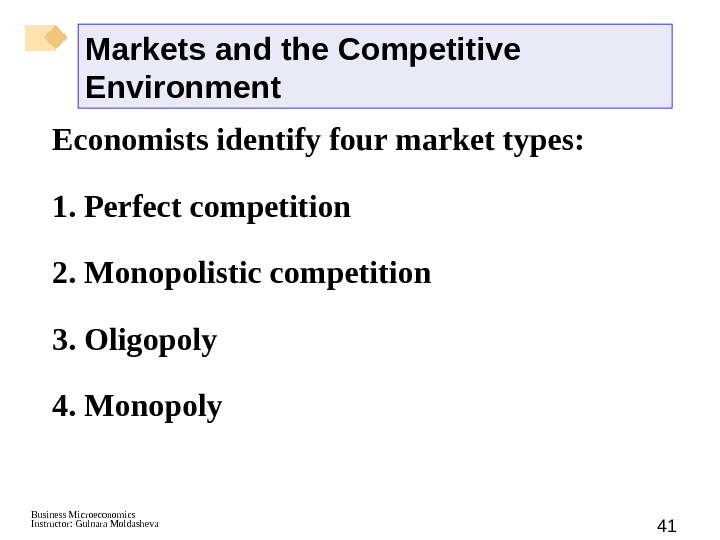
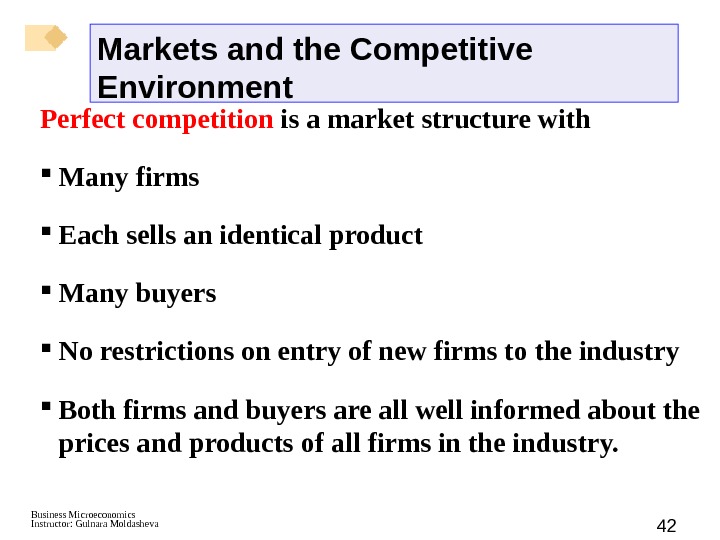
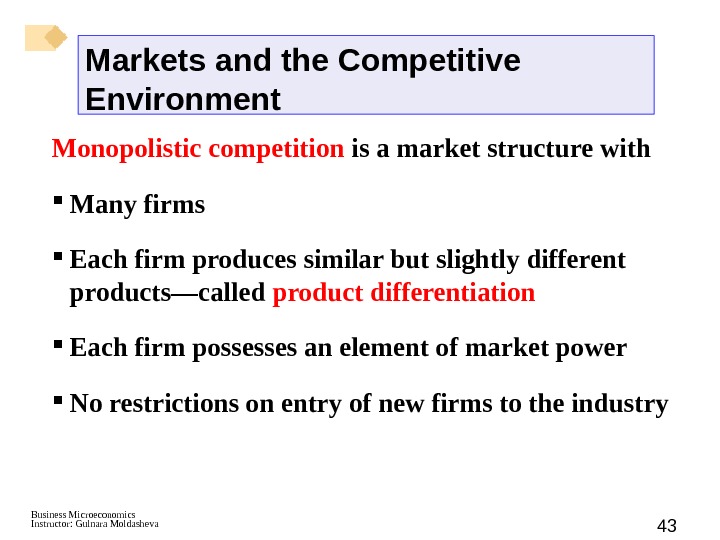
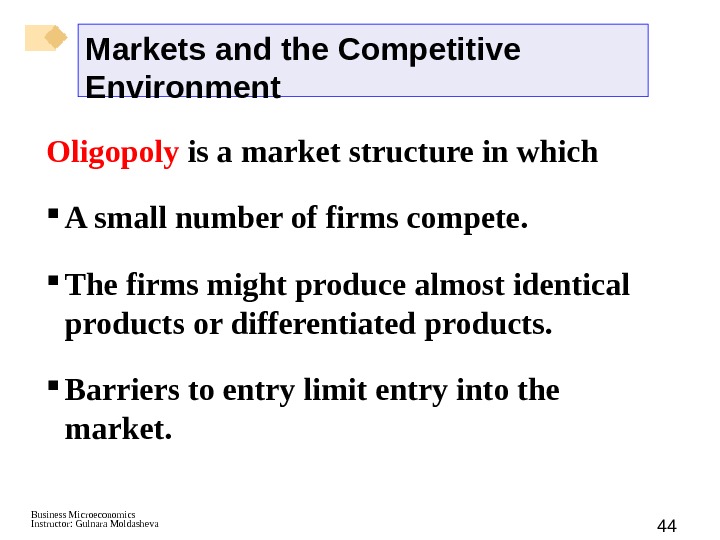
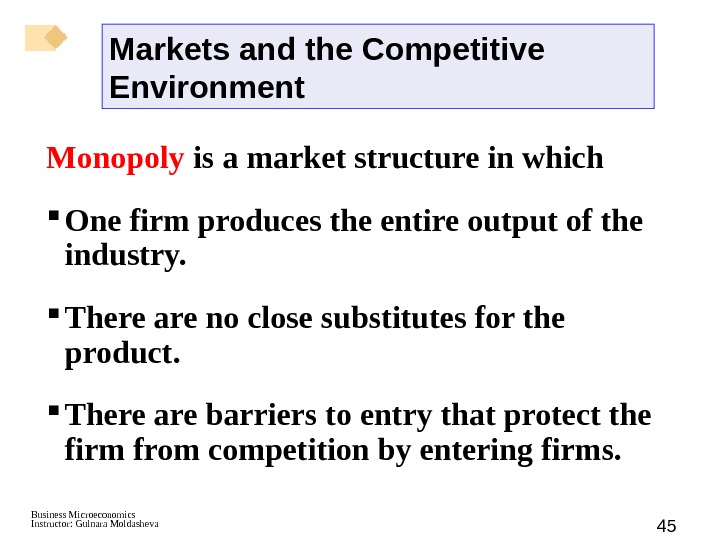
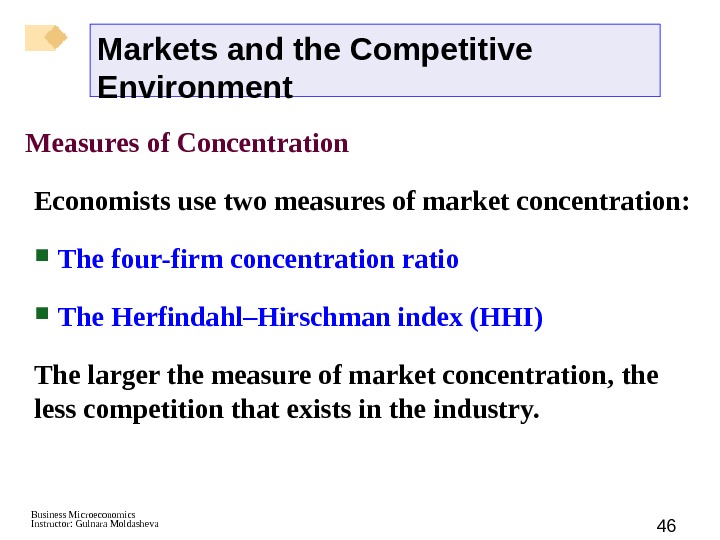

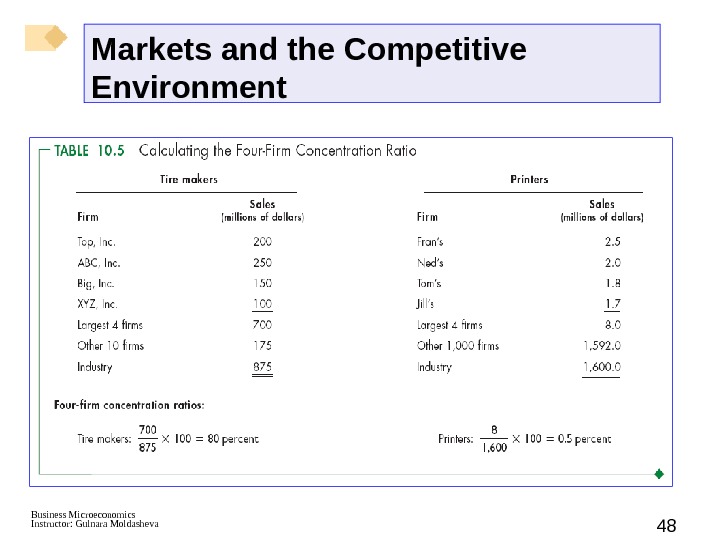
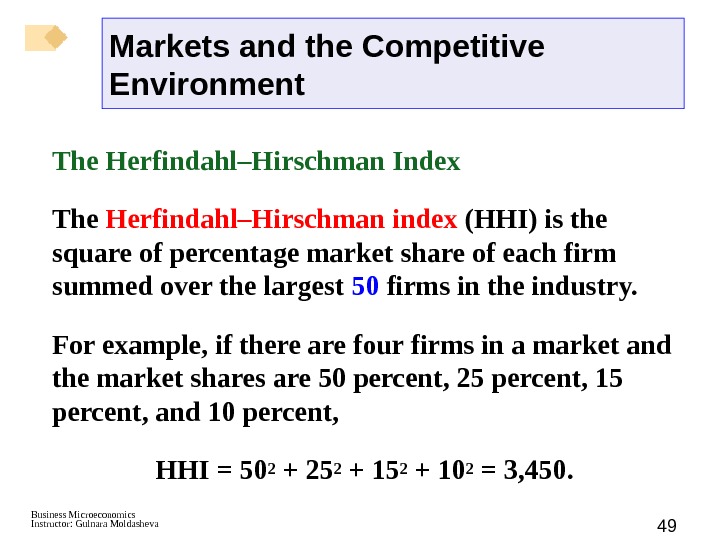
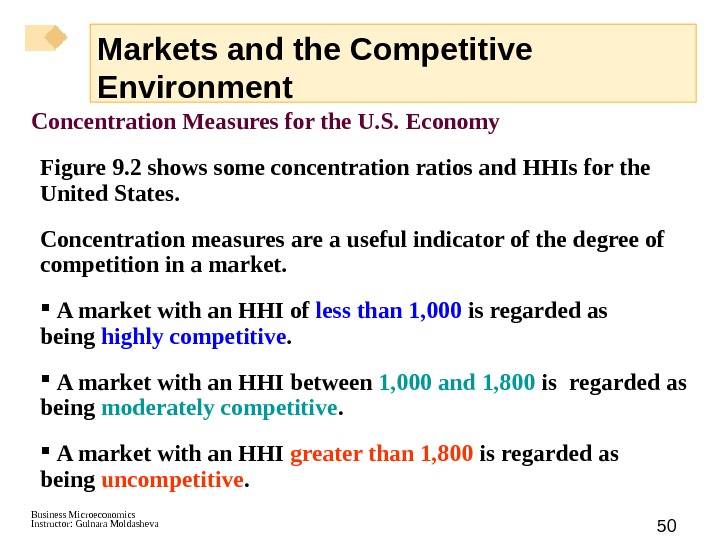



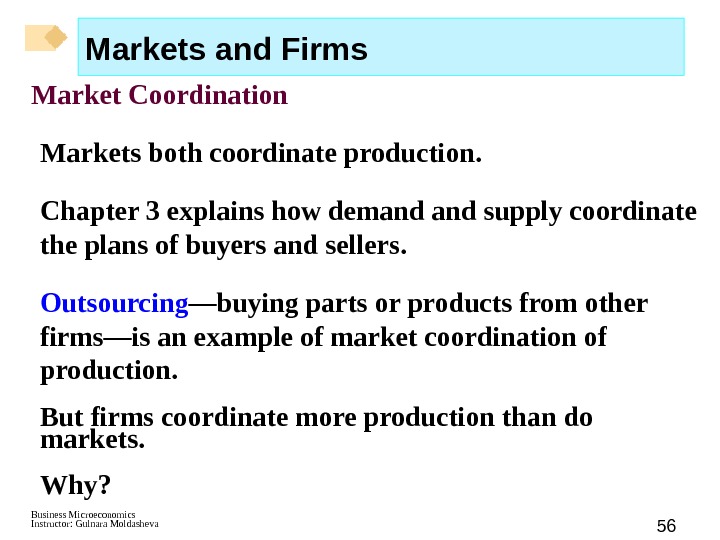
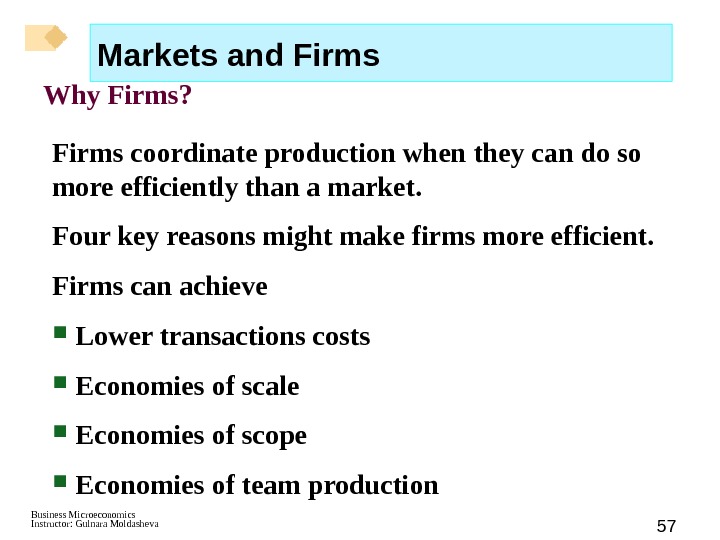
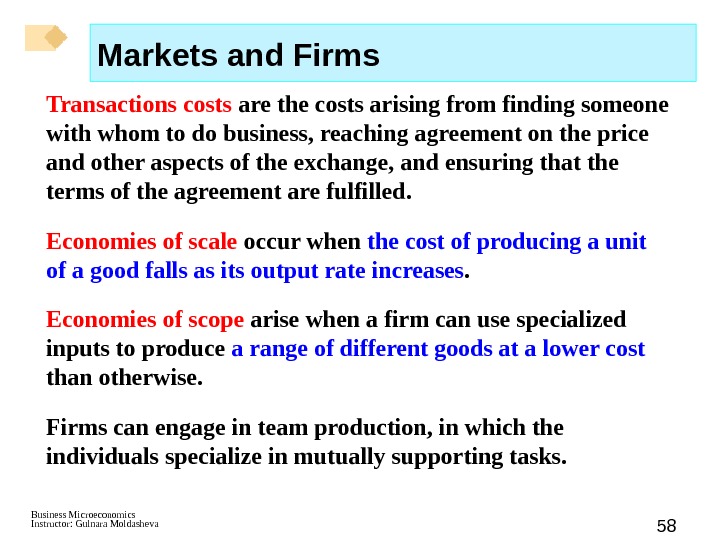



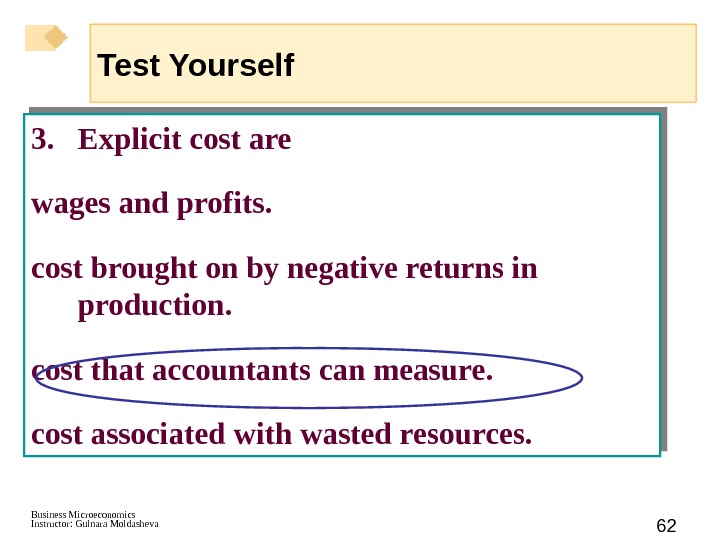
sess_6_organizing_production_ch_10.ppt
- Размер: 1.3 Mегабайта
- Количество слайдов: 59
Описание презентации Business Microeconomics Instructor: Gulnara Moldasheva 1 Organizing Production по слайдам
 Business Microeconomics Instructor: Gulnara Moldasheva 1 Organizing Production CHAPTER
Business Microeconomics Instructor: Gulnara Moldasheva 1 Organizing Production CHAPTER
 Business Microeconomics Instructor: Gulnara Moldasheva 2 After studying this chapter you will be able to Explain what a firm is and describe the economic problems that all firms face Distinguish between technological efficiency and economic efficiency Define and explain the principal-agent problem and describe how different types of business organizations cope with this problem Describe and distinguish between different types of markets in which firms operate Explain why markets coordinate some economic activities and firms coordinate others
Business Microeconomics Instructor: Gulnara Moldasheva 2 After studying this chapter you will be able to Explain what a firm is and describe the economic problems that all firms face Distinguish between technological efficiency and economic efficiency Define and explain the principal-agent problem and describe how different types of business organizations cope with this problem Describe and distinguish between different types of markets in which firms operate Explain why markets coordinate some economic activities and firms coordinate others
 Business Microeconomics Instructor: Gulnara Moldasheva 3 The invention of the World Wide Web has paved the way for the creation of thousands of profitable businesses, such as Google, Inc. How do Google and the other 20 million firms in the United States make their business decisions? Most of the firms don’t make things; they buy and sell things. For example, Apple doesn’t make the i. Pod. Toshiba makes the i. Pod’s hard drive and display module and Inventec assembles the i. Pod. Why doesn’t Apple make its i. Pod? How do firms decide what to make themselves and what to buy from other firms?
Business Microeconomics Instructor: Gulnara Moldasheva 3 The invention of the World Wide Web has paved the way for the creation of thousands of profitable businesses, such as Google, Inc. How do Google and the other 20 million firms in the United States make their business decisions? Most of the firms don’t make things; they buy and sell things. For example, Apple doesn’t make the i. Pod. Toshiba makes the i. Pod’s hard drive and display module and Inventec assembles the i. Pod. Why doesn’t Apple make its i. Pod? How do firms decide what to make themselves and what to buy from other firms?
 Business Microeconomics Instructor: Gulnara Moldasheva 4 The Firm and Its Economic Problem A firm is an institution that hires factors of production and organizes them to produce and sell goods and services. The Firm’s Goal A firm’s goal is to maximize profit. If the firm fails to maximize its profit, the firm is either eliminated or bought out by other firms seeking to maximize profit.
Business Microeconomics Instructor: Gulnara Moldasheva 4 The Firm and Its Economic Problem A firm is an institution that hires factors of production and organizes them to produce and sell goods and services. The Firm’s Goal A firm’s goal is to maximize profit. If the firm fails to maximize its profit, the firm is either eliminated or bought out by other firms seeking to maximize profit.
 Business Microeconomics Instructor: Gulnara Moldasheva 5 Accounting Profit Accountants measure a firm’s profit to ensure that the firm pays the correct amount of tax and to show it investors how their funds are being used. π =TR-TC = Profit equals total revenue minus total cost Accountants use Internal Revenue Service rules based on standards established by the Financial Accounting Standards Board to calculate a firm’s depreciation cost. The Firm and Its Economic Problem
Business Microeconomics Instructor: Gulnara Moldasheva 5 Accounting Profit Accountants measure a firm’s profit to ensure that the firm pays the correct amount of tax and to show it investors how their funds are being used. π =TR-TC = Profit equals total revenue minus total cost Accountants use Internal Revenue Service rules based on standards established by the Financial Accounting Standards Board to calculate a firm’s depreciation cost. The Firm and Its Economic Problem
 Business Microeconomics Instructor: Gulnara Moldasheva 6 Economic Profit Economists measure a firm’s profit to enable them to predict the firm’s decisions, and the goal of these decisions in to maximize economic profit. Economic profit is equal to total revenue minus total cost, with total cost measured as the opportunity cost of production. The Firm and Its Economic Problem
Business Microeconomics Instructor: Gulnara Moldasheva 6 Economic Profit Economists measure a firm’s profit to enable them to predict the firm’s decisions, and the goal of these decisions in to maximize economic profit. Economic profit is equal to total revenue minus total cost, with total cost measured as the opportunity cost of production. The Firm and Its Economic Problem
 Business Microeconomics Instructor: Gulnara Moldasheva 7 A Firm’s Opportunity Cost of Production A firm’s opportunity cost of production is the value of the best alternative use of the resources that a firm uses in production. A firm’s opportunity cost of production is the sum of the cost of using resources Bought in the market Owned by the firm Supplied by the firm’s owner The Firm and Its Economic Problem
Business Microeconomics Instructor: Gulnara Moldasheva 7 A Firm’s Opportunity Cost of Production A firm’s opportunity cost of production is the value of the best alternative use of the resources that a firm uses in production. A firm’s opportunity cost of production is the sum of the cost of using resources Bought in the market Owned by the firm Supplied by the firm’s owner The Firm and Its Economic Problem
 Business Microeconomics Instructor: Gulnara Moldasheva 8 Resources Bought in the Market The amount spent by a firm on resources bought in the market is an opportunity cost of production because the firm could have bought different resources to produce some other good or service. The Firm and Its Economic Problem
Business Microeconomics Instructor: Gulnara Moldasheva 8 Resources Bought in the Market The amount spent by a firm on resources bought in the market is an opportunity cost of production because the firm could have bought different resources to produce some other good or service. The Firm and Its Economic Problem
 Business Microeconomics Instructor: Gulnara Moldasheva 9 Resources Owned by the Firm If the firm owns capital and uses it to produce its output, then the firm incur an opportunity cost. The firm incurs an opportunity cost of production because it could have sold the capital and rented capital from another firm. The firm implicitly rent the capital from itself. The firm’s opportunity cost of using the capital it owns is called the implicit rental rate of capital. The Firm and Its Economic Problem
Business Microeconomics Instructor: Gulnara Moldasheva 9 Resources Owned by the Firm If the firm owns capital and uses it to produce its output, then the firm incur an opportunity cost. The firm incurs an opportunity cost of production because it could have sold the capital and rented capital from another firm. The firm implicitly rent the capital from itself. The firm’s opportunity cost of using the capital it owns is called the implicit rental rate of capital. The Firm and Its Economic Problem
 Business Microeconomics Instructor: Gulnara Moldasheva 10 The implicit rental rate of capital is made up of 1. Economic depreciation 2. Interest forgone Economic depreciation is the change in the market value of capital over a given period. Interest forgone is the return on the funds used to acquire the capital. The Firm and Its Economic Problem
Business Microeconomics Instructor: Gulnara Moldasheva 10 The implicit rental rate of capital is made up of 1. Economic depreciation 2. Interest forgone Economic depreciation is the change in the market value of capital over a given period. Interest forgone is the return on the funds used to acquire the capital. The Firm and Its Economic Problem
 Business Microeconomics Instructor: Gulnara Moldasheva 11 Resources Supplied by the Firm’s Owner The owner might supply both entrepreneurship and labor. The return to entrepreneurship is profit. The profit that an entrepreneur can expect to receive on average is called normal profit. Normal profit is the cost of entrepreneurship and is a cost of production. The Firm and Its Economic Problem
Business Microeconomics Instructor: Gulnara Moldasheva 11 Resources Supplied by the Firm’s Owner The owner might supply both entrepreneurship and labor. The return to entrepreneurship is profit. The profit that an entrepreneur can expect to receive on average is called normal profit. Normal profit is the cost of entrepreneurship and is a cost of production. The Firm and Its Economic Problem
 Business Microeconomics Instructor: Gulnara Moldasheva 12 In addition to supplying entrepreneurship, the owner might supply labor but not take as wage. The opportunity cost of the owner’s labor is the wage income forgone by not taking the best alternative job. Economic Accounting: A Summary Economic profit equals a firm’s total revenue minus its total opportunity cost of production. The example in Table 10. 1 on the next slide summarizes the economic accounting. The Firm and Its Economic Problem
Business Microeconomics Instructor: Gulnara Moldasheva 12 In addition to supplying entrepreneurship, the owner might supply labor but not take as wage. The opportunity cost of the owner’s labor is the wage income forgone by not taking the best alternative job. Economic Accounting: A Summary Economic profit equals a firm’s total revenue minus its total opportunity cost of production. The example in Table 10. 1 on the next slide summarizes the economic accounting. The Firm and Its Economic Problem
 Business Microeconomics Instructor: Gulnara Moldasheva 13 The Firm and Its Economic Problem
Business Microeconomics Instructor: Gulnara Moldasheva 13 The Firm and Its Economic Problem
 Business Microeconomics Instructor: Gulnara Moldasheva 14 The Firm’s Decisions To maximize profit, a firm must make five basic decisions: 1. What to produce and in what quantities 2. How to produce 3. How to organize and compensate its managers and workers 4. How to market and price its products 5. What to produce itself and what to buy from other firms The Firm and Its Economic Problem
Business Microeconomics Instructor: Gulnara Moldasheva 14 The Firm’s Decisions To maximize profit, a firm must make five basic decisions: 1. What to produce and in what quantities 2. How to produce 3. How to organize and compensate its managers and workers 4. How to market and price its products 5. What to produce itself and what to buy from other firms The Firm and Its Economic Problem
 Business Microeconomics Instructor: Gulnara Moldasheva 15 The Firm’s Constraints The firm’s profit is limited by three features of the environment: Technology constraints Information constraints Market constraints The Firm and Its Economic Problem
Business Microeconomics Instructor: Gulnara Moldasheva 15 The Firm’s Constraints The firm’s profit is limited by three features of the environment: Technology constraints Information constraints Market constraints The Firm and Its Economic Problem
 Business Microeconomics Instructor: Gulnara Moldasheva 16 Technology Constraints Technology is any method of producing a good or service. Technology advances over time. Using the available technology, the firm can produce more only if it hires more resources, which will increase its costs and limit the profit of additional output. The Firm and Its Economic Problem
Business Microeconomics Instructor: Gulnara Moldasheva 16 Technology Constraints Technology is any method of producing a good or service. Technology advances over time. Using the available technology, the firm can produce more only if it hires more resources, which will increase its costs and limit the profit of additional output. The Firm and Its Economic Problem
 Business Microeconomics Instructor: Gulnara Moldasheva 17 Information Constraints A firm never possesses complete information about either the present or the future. It is constrained by limited information about the quality and effort of its work force, current and future buying plans of its customers, and the plans of its competitors. The cost of coping with limited information limits profit. The Firm and Its Economic Problem
Business Microeconomics Instructor: Gulnara Moldasheva 17 Information Constraints A firm never possesses complete information about either the present or the future. It is constrained by limited information about the quality and effort of its work force, current and future buying plans of its customers, and the plans of its competitors. The cost of coping with limited information limits profit. The Firm and Its Economic Problem
 Business Microeconomics Instructor: Gulnara Moldasheva 18 Market Constraints What a firm can sell and the price it can obtain are constrained by its customers’ willingness to pay and by the prices and marketing efforts of other firms. The resources that a firm can buy and the prices it must pay for them are limited by the willingness of people to work for and invest in the firm. The expenditures a firm incurs to overcome these market constraints will limit the profit the firm can make. The Firm and Its Economic Problem
Business Microeconomics Instructor: Gulnara Moldasheva 18 Market Constraints What a firm can sell and the price it can obtain are constrained by its customers’ willingness to pay and by the prices and marketing efforts of other firms. The resources that a firm can buy and the prices it must pay for them are limited by the willingness of people to work for and invest in the firm. The expenditures a firm incurs to overcome these market constraints will limit the profit the firm can make. The Firm and Its Economic Problem
 Business Microeconomics Instructor: Gulnara Moldasheva 19 Technology and Economic Efficiency Technological efficiency occurs when a firm produces a given level of output by using the least amount inputs. There may be different combinations of inputs to use for producing a given good, but only one of them is technologically inefficient. If it is impossible to produce a given good by decreasing any one input, holding all other inputs constant, then production is technologically efficient.
Business Microeconomics Instructor: Gulnara Moldasheva 19 Technology and Economic Efficiency Technological efficiency occurs when a firm produces a given level of output by using the least amount inputs. There may be different combinations of inputs to use for producing a given good, but only one of them is technologically inefficient. If it is impossible to produce a given good by decreasing any one input, holding all other inputs constant, then production is technologically efficient.
 Business Microeconomics Instructor: Gulnara Moldasheva 20 Technology and Economic Efficiency Table 10. 2 sets out the labor and capital required to produce 10 TVs a day by four methods A , B , C , and D. Which methods are technologically efficient?
Business Microeconomics Instructor: Gulnara Moldasheva 20 Technology and Economic Efficiency Table 10. 2 sets out the labor and capital required to produce 10 TVs a day by four methods A , B , C , and D. Which methods are technologically efficient?
 Business Microeconomics Instructor: Gulnara Moldasheva 21 Economic Efficiency Economic efficiency occurs when the firm produces a given level of output at the least cost. The economically efficient method depends on the relative costs of capital and labor. The difference between technological and economic efficiency is that technological efficiency concerns the quantity of inputs used in production for a given level of output , whereas economic efficiency concerns the cost of the inputs used. Technology and Economic Efficiency
Business Microeconomics Instructor: Gulnara Moldasheva 21 Economic Efficiency Economic efficiency occurs when the firm produces a given level of output at the least cost. The economically efficient method depends on the relative costs of capital and labor. The difference between technological and economic efficiency is that technological efficiency concerns the quantity of inputs used in production for a given level of output , whereas economic efficiency concerns the cost of the inputs used. Technology and Economic Efficiency
 Business Microeconomics Instructor: Gulnara Moldasheva 22 An economically efficient production process also is technologically efficient. A technologically efficient process may not be economically efficient. Table 10. 3 on the next slide illustrates how the economically efficient method depends on the relative costs of resources. Technology and Economic Efficiency
Business Microeconomics Instructor: Gulnara Moldasheva 22 An economically efficient production process also is technologically efficient. A technologically efficient process may not be economically efficient. Table 10. 3 on the next slide illustrates how the economically efficient method depends on the relative costs of resources. Technology and Economic Efficiency
 Business Microeconomics Instructor: Gulnara Moldasheva 23 Technology and Economic Efficiency When the wage rate is $75 a day and the rental rate is $250 a day, Method B is the economically efficient method. When the wage rate is $150 a day and the rental rate is $1 a day, Method A is the economically efficient method. When the wage rate is $1 a day and the rental rate is $1, 000 a day, Method C is the economically efficient method.
Business Microeconomics Instructor: Gulnara Moldasheva 23 Technology and Economic Efficiency When the wage rate is $75 a day and the rental rate is $250 a day, Method B is the economically efficient method. When the wage rate is $150 a day and the rental rate is $1 a day, Method A is the economically efficient method. When the wage rate is $1 a day and the rental rate is $1, 000 a day, Method C is the economically efficient method.
 Business Microeconomics Instructor: Gulnara Moldasheva 25 Information and Organization A firm organizes production by combining and coordinating productive resources using a mixture of two systems: Command systems Incentive systems
Business Microeconomics Instructor: Gulnara Moldasheva 25 Information and Organization A firm organizes production by combining and coordinating productive resources using a mixture of two systems: Command systems Incentive systems
 Business Microeconomics Instructor: Gulnara Moldasheva 26 Command Systems A command system uses a managerial hierarchy. Commands pass downward through the hierarchy and information (feedback) passes upward. These systems are relatively rigid and can have many layers of specialized management. Information and Organization
Business Microeconomics Instructor: Gulnara Moldasheva 26 Command Systems A command system uses a managerial hierarchy. Commands pass downward through the hierarchy and information (feedback) passes upward. These systems are relatively rigid and can have many layers of specialized management. Information and Organization
 Business Microeconomics Instructor: Gulnara Moldasheva 27 Incentive Systems An incentive system is a method of organizing production that uses a market-like mechanism to induce workers to perform in ways that maximize the firm’s profit. Information and Organization
Business Microeconomics Instructor: Gulnara Moldasheva 27 Incentive Systems An incentive system is a method of organizing production that uses a market-like mechanism to induce workers to perform in ways that maximize the firm’s profit. Information and Organization
 Business Microeconomics Instructor: Gulnara Moldasheva 28 Mixing the Systems Most firms use a mix of command incentive systems to maximize profit. They use commands when it is easy to monitor performance or when a small deviation from the ideal performance is very costly. They use incentives whenever monitoring performance is impossible or too costly to be worth doing. Information and Organization
Business Microeconomics Instructor: Gulnara Moldasheva 28 Mixing the Systems Most firms use a mix of command incentive systems to maximize profit. They use commands when it is easy to monitor performance or when a small deviation from the ideal performance is very costly. They use incentives whenever monitoring performance is impossible or too costly to be worth doing. Information and Organization
 Business Microeconomics Instructor: Gulnara Moldasheva 29 The Principal–Agent Problem The principal–agent problem is the problem of devising compensation rules that induce an agent to act in the best interests of a principal. For example, the stockholders of a firm are the principals and the managers of the firm are their agents. Information and Organization
Business Microeconomics Instructor: Gulnara Moldasheva 29 The Principal–Agent Problem The principal–agent problem is the problem of devising compensation rules that induce an agent to act in the best interests of a principal. For example, the stockholders of a firm are the principals and the managers of the firm are their agents. Information and Organization
 Business Microeconomics Instructor: Gulnara Moldasheva 30 Coping with the Principal–Agent Problem Three ways of coping with the principal–agent problem are Ownership Incentive pay Long-term contracts Information and Organization
Business Microeconomics Instructor: Gulnara Moldasheva 30 Coping with the Principal–Agent Problem Three ways of coping with the principal–agent problem are Ownership Incentive pay Long-term contracts Information and Organization
 Business Microeconomics Instructor: Gulnara Moldasheva 31 Ownership , often offered to managers, gives the managers an incentive to maximize the firm’s profits, which is the goal of the owners, the principals. Incentive pay links managers’ or workers’ pay to the firm’s performance and helps align the managers’ and workers’ interests with those of the owners, the principals. Long-term contracts can tie managers’ or workers’ long-term rewards to the long-term performance of the firm. This arrangement encourages the agents work in the best long-term interests of the firm owners, the principals. Information and Organization
Business Microeconomics Instructor: Gulnara Moldasheva 31 Ownership , often offered to managers, gives the managers an incentive to maximize the firm’s profits, which is the goal of the owners, the principals. Incentive pay links managers’ or workers’ pay to the firm’s performance and helps align the managers’ and workers’ interests with those of the owners, the principals. Long-term contracts can tie managers’ or workers’ long-term rewards to the long-term performance of the firm. This arrangement encourages the agents work in the best long-term interests of the firm owners, the principals. Information and Organization
 Business Microeconomics Instructor: Gulnara Moldasheva 32 Types of Business Organization There are three types of business organization: Proprietorship Partnership Corporation Information and Organization
Business Microeconomics Instructor: Gulnara Moldasheva 32 Types of Business Organization There are three types of business organization: Proprietorship Partnership Corporation Information and Organization
 Business Microeconomics Instructor: Gulnara Moldasheva 33 Proprietorship A proprietorship is a firm with a single owner who has unlimited liability , or legal responsibility for all debts incurred by the firm—up to an amount equal to the entire wealth of the owner. The proprietor also makes management decisions and receives the firm’s profit. Profits are taxed the same as the owner’s other income. Information and Organization
Business Microeconomics Instructor: Gulnara Moldasheva 33 Proprietorship A proprietorship is a firm with a single owner who has unlimited liability , or legal responsibility for all debts incurred by the firm—up to an amount equal to the entire wealth of the owner. The proprietor also makes management decisions and receives the firm’s profit. Profits are taxed the same as the owner’s other income. Information and Organization
 Business Microeconomics Instructor: Gulnara Moldasheva 34 Partnership A partnership is a firm with two or more owners who have unlimited liability. Partners must agree on a management structure and how to divide up the profits. Profits from partnerships are taxed as the personal income of the owners. Information and Organization
Business Microeconomics Instructor: Gulnara Moldasheva 34 Partnership A partnership is a firm with two or more owners who have unlimited liability. Partners must agree on a management structure and how to divide up the profits. Profits from partnerships are taxed as the personal income of the owners. Information and Organization
 Business Microeconomics Instructor: Gulnara Moldasheva 35 Corporation A corporation is owned by one or more stockholders with limited liability , which means the owners who have legal liability only for the initial value of their investment. The personal wealth of the stockholders is not at risk if the firm goes bankrupt. The profit of corporations is taxed twice—once as a corporate tax on firm profits, and then again as income taxes paid by stockholders receiving their after-tax profits distributed as dividends. Information and Organization
Business Microeconomics Instructor: Gulnara Moldasheva 35 Corporation A corporation is owned by one or more stockholders with limited liability , which means the owners who have legal liability only for the initial value of their investment. The personal wealth of the stockholders is not at risk if the firm goes bankrupt. The profit of corporations is taxed twice—once as a corporate tax on firm profits, and then again as income taxes paid by stockholders receiving their after-tax profits distributed as dividends. Information and Organization
 Business Microeconomics Instructor: Gulnara Moldasheva 36 Pros and Cons of Different Types of Firms Each type of business organization has advantages and disadvantages. Table 10. 4 summarizes the pros and cons of different types of firms. Information and Organization
Business Microeconomics Instructor: Gulnara Moldasheva 36 Pros and Cons of Different Types of Firms Each type of business organization has advantages and disadvantages. Table 10. 4 summarizes the pros and cons of different types of firms. Information and Organization
 Business Microeconomics Instructor: Gulnara Moldasheva
Business Microeconomics Instructor: Gulnara Moldasheva
 Business Microeconomics Instructor: Gulnara Moldasheva 38 Proprietorships Are easy to set up Managerial decision making is simple Profits are taxed only once as owner’s income But bad decisions made by the manager are not subject to review The owner’s entire wealth is at stake The firm dies with the owner The cost of capital and labor can be high Information and Organization
Business Microeconomics Instructor: Gulnara Moldasheva 38 Proprietorships Are easy to set up Managerial decision making is simple Profits are taxed only once as owner’s income But bad decisions made by the manager are not subject to review The owner’s entire wealth is at stake The firm dies with the owner The cost of capital and labor can be high Information and Organization
 Business Microeconomics Instructor: Gulnara Moldasheva 39 Partnerships Are easy to set up Employ diversified decision-making processes Can survive the withdrawal of a partner Profits are taxed only once But achieving a consensus about managerial decisions difficult Owners’ entire wealth is at risk Capital is expensive Information and Organization
Business Microeconomics Instructor: Gulnara Moldasheva 39 Partnerships Are easy to set up Employ diversified decision-making processes Can survive the withdrawal of a partner Profits are taxed only once But achieving a consensus about managerial decisions difficult Owners’ entire wealth is at risk Capital is expensive Information and Organization
 Business Microeconomics Instructor: Gulnara Moldasheva 40 Corporation Limited liability for its owners Large-scale and low-cost capital that is readily available Professional management Lower costs from long-term labor contracts But complex management structure may lead to slow and expensive Profits taxed twice—as corporate profit and shareholder income. Information and Organization
Business Microeconomics Instructor: Gulnara Moldasheva 40 Corporation Limited liability for its owners Large-scale and low-cost capital that is readily available Professional management Lower costs from long-term labor contracts But complex management structure may lead to slow and expensive Profits taxed twice—as corporate profit and shareholder income. Information and Organization
 Business Microeconomics Instructor: Gulnara Moldasheva 41 Markets and the Competitive Environment Economists identify four market types: 1. Perfect competition 2. Monopolistic competition 3. Oligopoly 4. Monopoly
Business Microeconomics Instructor: Gulnara Moldasheva 41 Markets and the Competitive Environment Economists identify four market types: 1. Perfect competition 2. Monopolistic competition 3. Oligopoly 4. Monopoly
 Business Microeconomics Instructor: Gulnara Moldasheva 42 Perfect competition is a market structure with Many firms Each sells an identical product Many buyers No restrictions on entry of new firms to the industry Both firms and buyers are all well informed about the prices and products of all firms in the industry. Markets and the Competitive Environment
Business Microeconomics Instructor: Gulnara Moldasheva 42 Perfect competition is a market structure with Many firms Each sells an identical product Many buyers No restrictions on entry of new firms to the industry Both firms and buyers are all well informed about the prices and products of all firms in the industry. Markets and the Competitive Environment
 Business Microeconomics Instructor: Gulnara Moldasheva 43 Monopolistic competition is a market structure with Many firms Each firm produces similar but slightly different products—called product differentiation Each firm possesses an element of market power No restrictions on entry of new firms to the industry Markets and the Competitive Environment
Business Microeconomics Instructor: Gulnara Moldasheva 43 Monopolistic competition is a market structure with Many firms Each firm produces similar but slightly different products—called product differentiation Each firm possesses an element of market power No restrictions on entry of new firms to the industry Markets and the Competitive Environment
 Business Microeconomics Instructor: Gulnara Moldasheva 44 Oligopoly is a market structure in which A small number of firms compete. The firms might produce almost identical products or differentiated products. Barriers to entry limit entry into the market. Markets and the Competitive Environment
Business Microeconomics Instructor: Gulnara Moldasheva 44 Oligopoly is a market structure in which A small number of firms compete. The firms might produce almost identical products or differentiated products. Barriers to entry limit entry into the market. Markets and the Competitive Environment
 Business Microeconomics Instructor: Gulnara Moldasheva 45 Monopoly is a market structure in which One firm produces the entire output of the industry. There are no close substitutes for the product. There are barriers to entry that protect the firm from competition by entering firms. Markets and the Competitive Environment
Business Microeconomics Instructor: Gulnara Moldasheva 45 Monopoly is a market structure in which One firm produces the entire output of the industry. There are no close substitutes for the product. There are barriers to entry that protect the firm from competition by entering firms. Markets and the Competitive Environment
 Business Microeconomics Instructor: Gulnara Moldasheva 46 Measures of Concentration Economists use two measures of market concentration: The four-firm concentration ratio The Herfindahl–Hirschman index (HHI) The larger the measure of market concentration, the less competition that exists in the industry. Markets and the Competitive Environment
Business Microeconomics Instructor: Gulnara Moldasheva 46 Measures of Concentration Economists use two measures of market concentration: The four-firm concentration ratio The Herfindahl–Hirschman index (HHI) The larger the measure of market concentration, the less competition that exists in the industry. Markets and the Competitive Environment
 Business Microeconomics Instructor: Gulnara Moldasheva 47 The Four-Firm Concentration Ratio The four-firm concentration ratio is the percentage of the total industry sales accounted for by the four largest firms in the industry. Table 10. 5 on the next slide shows two calculations of the four-firm concentration ratio. Markets and the Competitive Environment
Business Microeconomics Instructor: Gulnara Moldasheva 47 The Four-Firm Concentration Ratio The four-firm concentration ratio is the percentage of the total industry sales accounted for by the four largest firms in the industry. Table 10. 5 on the next slide shows two calculations of the four-firm concentration ratio. Markets and the Competitive Environment
 Business Microeconomics Instructor: Gulnara Moldasheva 48 Markets and the Competitive Environment
Business Microeconomics Instructor: Gulnara Moldasheva 48 Markets and the Competitive Environment
 Business Microeconomics Instructor: Gulnara Moldasheva 49 The Herfindahl–Hirschman Index The Herfindahl–Hirschman index (HHI) is the square of percentage market share of each firm summed over the largest 50 firms in the industry. For example, if there are four firms in a market and the market shares are 50 percent, 25 percent, 15 percent, and 10 percent, HHI = 502 + 252 + 102 = 3, 450. Markets and the Competitive Environment
Business Microeconomics Instructor: Gulnara Moldasheva 49 The Herfindahl–Hirschman Index The Herfindahl–Hirschman index (HHI) is the square of percentage market share of each firm summed over the largest 50 firms in the industry. For example, if there are four firms in a market and the market shares are 50 percent, 25 percent, 15 percent, and 10 percent, HHI = 502 + 252 + 102 = 3, 450. Markets and the Competitive Environment
 Business Microeconomics Instructor: Gulnara Moldasheva 50 Markets and the Competitive Environment Concentration Measures for the U. S. Economy Figure 9. 2 shows some concentration ratios and HHIs for the United States. Concentration measures are a useful indicator of the degree of competition in a market. A market with an HHI of less than 1, 000 is regarded as being highly competitive. A market with an HHI between 1, 000 and 1, 800 is regarded as being moderately competitive. A market with an HHI greater than 1, 800 is regarded as being uncompetitive.
Business Microeconomics Instructor: Gulnara Moldasheva 50 Markets and the Competitive Environment Concentration Measures for the U. S. Economy Figure 9. 2 shows some concentration ratios and HHIs for the United States. Concentration measures are a useful indicator of the degree of competition in a market. A market with an HHI of less than 1, 000 is regarded as being highly competitive. A market with an HHI between 1, 000 and 1, 800 is regarded as being moderately competitive. A market with an HHI greater than 1, 800 is regarded as being uncompetitive.
 Business Microeconomics Instructor: Gulnara Moldasheva 51 Markets and the Competitive Environment Figure 10. 2 shows the four-firm concentratio n ratio for various industries in the United States.
Business Microeconomics Instructor: Gulnara Moldasheva 51 Markets and the Competitive Environment Figure 10. 2 shows the four-firm concentratio n ratio for various industries in the United States.
 Business Microeconomics Instructor: Gulnara Moldasheva 53 Limitations of Concentration Measures The main limitations of only using concentration measure as determinants of market structure are The geographical scope of the market Barriers to entry and firm turnover The correspondence between a market and an industry Markets and the Competitive Environment
Business Microeconomics Instructor: Gulnara Moldasheva 53 Limitations of Concentration Measures The main limitations of only using concentration measure as determinants of market structure are The geographical scope of the market Barriers to entry and firm turnover The correspondence between a market and an industry Markets and the Competitive Environment
 Business Microeconomics Instructor: Gulnara Moldasheva 54 Markets and the Competitive Environment Market Structures in the U. S. Economy Figure 9. 3 shows the distribution of market structures in the North American economy. The economy is mainly competitive.
Business Microeconomics Instructor: Gulnara Moldasheva 54 Markets and the Competitive Environment Market Structures in the U. S. Economy Figure 9. 3 shows the distribution of market structures in the North American economy. The economy is mainly competitive.
 Business Microeconomics Instructor: Gulnara Moldasheva 56 Markets and Firms Market Coordination Markets both coordinate production. Chapter 3 explains how demand supply coordinate the plans of buyers and sellers. Outsourcing —buying parts or products from other firms—is an example of market coordination of production. But firms coordinate more production than do markets. Why?
Business Microeconomics Instructor: Gulnara Moldasheva 56 Markets and Firms Market Coordination Markets both coordinate production. Chapter 3 explains how demand supply coordinate the plans of buyers and sellers. Outsourcing —buying parts or products from other firms—is an example of market coordination of production. But firms coordinate more production than do markets. Why?
 Business Microeconomics Instructor: Gulnara Moldasheva 57 Why Firms? Firms coordinate production when they can do so more efficiently than a market. Four key reasons might make firms more efficient. Firms can achieve Lower transactions costs Economies of scale Economies of scope Economies of team production Markets and Firms
Business Microeconomics Instructor: Gulnara Moldasheva 57 Why Firms? Firms coordinate production when they can do so more efficiently than a market. Four key reasons might make firms more efficient. Firms can achieve Lower transactions costs Economies of scale Economies of scope Economies of team production Markets and Firms
 Business Microeconomics Instructor: Gulnara Moldasheva 58 Transactions costs are the costs arising from finding someone with whom to do business, reaching agreement on the price and other aspects of the exchange, and ensuring that the terms of the agreement are fulfilled. Economies of scale occur when the cost of producing a unit of a good falls as its output rate increases. Economies of scope arise when a firm can use specialized inputs to produce a range of different goods at a lower cost than otherwise. Firms can engage in team production, in which the individuals specialize in mutually supporting tasks. Markets and Firms
Business Microeconomics Instructor: Gulnara Moldasheva 58 Transactions costs are the costs arising from finding someone with whom to do business, reaching agreement on the price and other aspects of the exchange, and ensuring that the terms of the agreement are fulfilled. Economies of scale occur when the cost of producing a unit of a good falls as its output rate increases. Economies of scope arise when a firm can use specialized inputs to produce a range of different goods at a lower cost than otherwise. Firms can engage in team production, in which the individuals specialize in mutually supporting tasks. Markets and Firms
 Business Microeconomics Instructor: Gulnara Moldasheva 59 Terms Along the Way firm corporation stock bond profit (economic profit) total revenue total cost explicit cost implicit opportunity cost (implicit cost) normal profit excess profit loss breakeven principal – agent problem
Business Microeconomics Instructor: Gulnara Moldasheva 59 Terms Along the Way firm corporation stock bond profit (economic profit) total revenue total cost explicit cost implicit opportunity cost (implicit cost) normal profit excess profit loss breakeven principal – agent problem
 Business Microeconomics Instructor: Gulnara Moldasheva 60 Test Yourself 1. Which is not a legal form of business? Sole proprietorship. Partnership. Corporation. Limited liability.
Business Microeconomics Instructor: Gulnara Moldasheva 60 Test Yourself 1. Which is not a legal form of business? Sole proprietorship. Partnership. Corporation. Limited liability.
 Business Microeconomics Instructor: Gulnara Moldasheva 61 Test Yourself 2. The stock exchanges are an example of a primary market. secondary market. sole proprietorship. mutual fund.
Business Microeconomics Instructor: Gulnara Moldasheva 61 Test Yourself 2. The stock exchanges are an example of a primary market. secondary market. sole proprietorship. mutual fund.
 Business Microeconomics Instructor: Gulnara Moldasheva 62 Test Yourself 3. Explicit cost are wages and profits. cost brought on by negative returns in production. cost that accountants can measure. cost associated with wasted resources.
Business Microeconomics Instructor: Gulnara Moldasheva 62 Test Yourself 3. Explicit cost are wages and profits. cost brought on by negative returns in production. cost that accountants can measure. cost associated with wasted resources.
